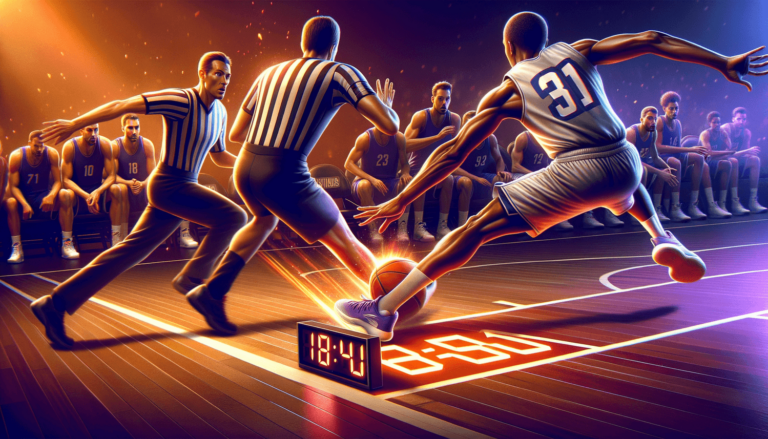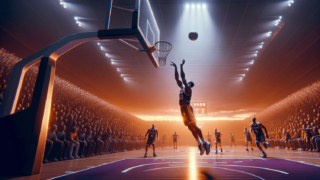
10-Second Backcourt Violation Rule in Basketball
Written by: Basketball Universe
Last updated:

Welcome to the fascinating world of basketball rules! In this blog post, we’ll take a deep dive into the 10-second backcourt violation rule, a truly pivotal aspect of the game that can make or break a team’s offensive strategy. Whether you’re a veteran fan or just starting to learn the ins and outs of basketball, this comprehensive breakdown of the rule will cover everything from its origins and purpose to the key tactics teams use to avoid this sneaky time-based constraint. So, lace up your sneakers, grab your favorite team’s jersey, and let’s master the nuances of the 10-second backcourt violation rule together!
10-Second Backcourt Violation Rule in Basketball
The 10-second backcourt violation rule in basketball dictates that a team must advance the ball from the backcourt, where they initially gain possession, to the frontcourt within 10 seconds. Failing to do so results in a violation, and the opposing team gets possession. The rule helps maintain a good pace and encourages teams to apply offensive strategies more effectively.
The History and Evolution of the 10-Second Rule
The origins of the 10-second backcourt violation rule date back to the early days of basketball. It was introduced to help maintain a swift pace, as the lack of a time constraint allowed teams to stall games and hold onto the ball. Over the years, the rule has evolved and adapted to the ever-changing dynamics of the game. Today, the 10-second rule is a crucial aspect of the game, as it encourages effective offensive strategies and sustained action.
The Rule’s Impact on the Game
The 10-second backcourt violation rule has had a tremendous impact on the overall flow of basketball games. By forcing teams to advance the ball within a strict time limit, the rule ensures that games don’t get bogged down with endless ball-holding or slow play. Moreover, it prevents teams from dominating possession and ensures that every squad has a fair chance to showcase their offense. This focus on speed and strategic play has helped elevate basketball as one of the most captivating sports around the world.
Understanding the Mechanics of the 10-Second Rule
To fully appreciate the intricacies of the 10-second rule, it’s essential to understand the mechanics and timing involved. The 10-second count begins as soon as a player gains possession of the ball in the backcourt. This could occur from an inbounds pass, a rebound, or on a turnover. The clock then starts ticking, and the offensive team must advance the ball past the half-court line within the designated 10 seconds.
How Officials Enforce the Rule
Enforcing the 10-second rule falls on the referees, who must keep a keen eye on the game and closely monitor the elapsed time. While they often rely on a mental count, officials can also use the game clock to confirm if the allotted time has passed. In certain cases, some leagues provide referees with a specialized shot-clock display for better accuracy. If a team fails to bring the ball across the half-court line within the required time, the officials will blow the whistle, signal the violation, and award the ball to the opposing team.
Strategies to Avoid 10-Second Violations
Effectively maneuvering around the 10-second backcourt violation rule is crucial for teams that aspire to excel in the world of basketball. Mastering these strategies not only enables players to avoid potential penalties but also propels the team toward a winning streak. Below are some invaluable tactics to dodge the 10-second violation and stay ahead in the game:
1. Quick Inbounds Passes
Initiating a smart and speedy inbounds pass is the first step toward success in evading the 10-second rule. Players must look for open teammates, anticipate their movement, and deliver a precise pass quickly to establish momentum and maximize precious seconds.
2. Rapid Ball Movement
Transferring the basketball across the court in record time requires rapid and purposeful ball movement. This can be achieved through various techniques, such as utilizing quick and swift short passes, employing effective dribbling skills, and making fast give-and-go plays.
3. Press Break Strategies
Implementing press break strategies is an essential aspect of breaking the opponents’ full-court defense and avoiding a 10-second violation. These tactics include setting screens, following the inbounder for a return pass, and utilizing the center of the court to negate defensive pressure.
Recognizing Common Pitfalls
While understanding effective tactics for overcoming the 10-second violation is necessary, it’s equally essential to recognize the common pitfalls that can lead to such a violation. Awareness of these pitfalls is instrumental in improving a team’s performance, averting unnecessary turnovers, and mastering the beautiful game of basketball.
Miscommunication Amongst Players
Efficient communication and synchronization on the court are critical. Miscommunication between teammates can lead to errant passes or an inability to advance the ball across the half-court line, potentially resulting in a 10-second violation.
Poor Decision-Making
A lack of strategic thinking or poor decision-making on the court can make it challenging to avoid the ticking 10-second clock. Such choices include holding the ball too long or dribbling without a purpose, thus enabling the opposing team to trap a player in the backcourt.
Unnecessary Dribbling
Excessive or unnecessary dribbling can waste valuable time and prevent the ball’s advancement to the frontcourt. Players must opt for quick passes or rapid dribbling bursts to breach the half-court line more efficiently.
Notable Exceptions to the 10-Second Rule
When it comes to basketball rules, there are always a few exceptions, and the 10-second backcourt violation is no different. It’s crucial for every basketball enthusiast to be aware of these special circumstances and understand their implications.
Resetting the Clock
Occasionally, the officials may stop the game due to faulty conditions, such as an issue with the court clock, a player’s injury, or an incorrect call. In such cases, if the stoppage occurred when the offensive team was in the backcourt, the officials may choose to reset the 10-second clock, allowing the team extra time to advance the ball.
Jump Ball Situations
About.
Adapting to Different Levels and Leagues
While the 10-second backcourt violation rule is most commonly discussed in the context of professional leagues, it’s essential to remember that it also exists in various forms across different levels and leagues of play. Understanding the nuances and adaptations of the rule in these contexts is crucial for players, coaches, and fans alike.
High School Basketball
In high school basketball, the National Federation of State High School Associations (NFHS) also enforces the 10-second rule. Similar to professional leagues, players must advance the ball to the frontcourt within the ten seconds allowed, or the opposing team gains possession. This promotes faster play and a focus on offensive strategy at an early stage of a player’s development.
International Basketball
The International Basketball Federation (FIBA), responsible for overseeing the rules in international competitions, similarly enforces the 10-second backcourt violation. The same principles apply, with timing commencing as soon as a player gains possession in the backcourt. The 10-second rule is consistent across the global basketball community, thus contributing to maintaining the pace and fairness of the game worldwide.
Influence on Coaching Strategies
The 10-second backcourt violation rule plays a critical role in shaping the strategies that coaches implement in both practice and actual games. From instilling disciplined communication and time management strategies to designing specific plays, this rule impacts the way teams adapt and perform.
Building Time Awareness
For coaches, consistently reinforcing the importance of time management is paramount. By integrating time-sensitive drills into practices, players can become more adept at anticipating and responding to the pressure of the ticking 10-second clock.
Developing Team Chemistry
The 10-second rule necessitates fluid teamwork, as players must coordinate their movements and passes efficiently to advance the ball effectively. Coaches invest in creating an environment that fosters trust, communication, and a deep understanding among teammates so that the chemistry on the court can manifest naturally to avoid potential violations.
Offensive Play Design
Coaches must create offensive plays that account for the 10-second backcourt violation rule, incorporating quick passes, screens, and motion to free up space for teammates. Tailoring plays to a team’s strengths and abilities ensures that they can overcome defensive pressure and avoid costly turnovers.
Impact on Fan Experience
For fans, understanding the intricacies of the 10-second rule adds depth and excitement to their basketball experience. Witnessing high-pressure situations, the tactical battle between offense and defense, and the unwavering focus of the players only adds to the joy of watching the sport.
Thrilling Offensive Displays
By encouraging swift offensive action, the 10-second rule adds excitement to each game. Fans can marvel at a team’s tactical skill as they navigate the defense and advance the ball under pressure, often culminating in an exhilarating and unexpected offensive play.
Engaging Defensive Strategies
The rule also serves as an incentive for teams to utilize aggressive full-court defensive tactics, pressuring the opposing team and trying to trap them in the backcourt. This intense defensive showdown and the possibility of a forced turnover create an engaging, edge-of-your-seat experience for fans.
Tension and Drama
The 10-second rule often brings drama and tension to integral moments in the game. Critical junctures, such as a close game in the final minutes or a nail-biting playoff series, are amplified by the need for teams to execute perfect plays under the constraint of the 10-second countdown. Fans can see the true mettle of their favorite players and teams as they perform under pressure, adding another thrilling layer to the basketball viewing experience.
FAQ: 10-Second Backcourt Violation Rule in Basketball
Whether you’re a newcomer to the game or simply looking to expand your basketball knowledge, it’s natural to have questions about the 10-second backcourt violation rule. Find quick, NLP-style answers to some of the most common questions surrounding this crucial aspect of the game in our FAQ section below.
1. What happens when a team commits a 10-second backcourt violation?
If a team commits a 10-second backcourt violation, they lose possession of the ball, and the opposing team takes over at the nearest sideline.
2. When does the 10-second count start?
The 10-second count starts as soon as a player gains possession of the ball in their backcourt, which can be due to an inbounds pass, a turnover, or a defensive rebound.
3. What happens if an additional timeout or game stoppage occurs during the 10-second count?
If a timeout or game stoppage happens during the 10-second count, the count usually pauses and then resumes when play restarts. However, if the stoppage was called by the offensive team, they lose any remaining seconds they initially had before the timeout.
4. How can a team avoid a 10-second backcourt violation?
To avoid a 10-second backcourt violation, a team should focus on quick inbounds passes, rapid ball movement, and utilizing press break strategies to effectively cross the half-court line within the time limit.
5. Does the 10-second rule apply to all levels of basketball?
Yes, the 10-second rule is enforced at all levels of basketball, including professional leagues, international competitions, and high school games, ensuring a consistent experience across the sport.
6. Who is responsible for enforcing the 10-second rule?
Referees are responsible for enforcing the 10-second rule, keeping a mental count or using the game clock to ensure the offensive team brings the ball to the frontcourt within the allotted time.
7. What are some common pitfalls that lead to 10-second backcourt violations?
Common pitfalls that can lead to 10-second backcourt violations include miscommunication among players, poor decision-making, and unnecessary dribbling that waste valuable time.
8. Can the 10-second clock be reset or restarted during a game?
The 10-second clock can be reset in some situations, such as when the game is stopped due to an issue with the court clock, a player’s injury, or an incorrect call, and the officials may decide to restart the count under these circumstances.
9. How does the 10-second rule impact coaching strategies in basketball?
The 10-second rule impacts coaching strategies by necessitating the development of time management skills, team chemistry, and offensive play designs that accommodate the time constraint.
10. How does the 10-second rule enhance the fan experience?
The 10-second rule enhances the fan experience by encouraging high-pressure situations, thrilling offensive displays, engaging defensive strategies, and fostering tension and drama in crucial moments of the game.
Featured Posts
- No pillar pages found.





